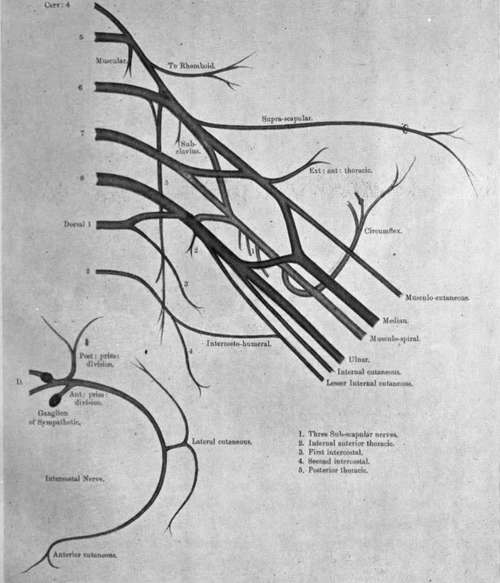Thoracic Nerves
Description
This section is from the book "Nerves Of The Human Body", by Charles R. Whittaker. Also available from Amazon: Hughes Nerves Of The Human Body.
Thoracic Nerves
With the exception of the first, the anterior primary divisions of the thoracic nerves do not form plexuses, but extend forwards singly under the name of intercostal nerves. The upper six are termed thoracic intercostal, the seventh to the eleventh, are abdominal intercostals, while the twelfth is called the subcostal.
Thoracic Intercostals
The thoracic intercostals communicate with the sympathetic near the intervertebral foramina, after which they pass in front of the superior costo-transverse ligament and the levatores costarum, being clothed by the pleura and the endo-thoracic fascia. Proceeding forwards between the internal and external intercostal muscles, the nerves about halfway between the sternum and the vertebral column, give off a lateral cutaneous branch. They subsequently continue their course, and near the sternum pierce the internal mammary vessels and triangularis sterni muscle, perforate the internal intercostal again, then the anterior intercostal membrane and the pectoralis major, to become the anterior cutaneous nerves.
Plate VIII. Brachial Plexus

The lateral cutaneous branches emerge through the external intercostals and serratus magnus (anterior.) After a short course, each divides into an anterior and a posterior branch; the anterior ones pass over the lower margin of the pectoralis major, and the posterior wind round the latissimus dorsi. The first intercostal has no lateral cutaneous branch; that of the second does not divide into anterior and posterior, but reaching the axilla becomes the intercosto-humeral nerve, which joins the lesser internal cutaneous of the brachial plexus.
Abdominal Intercostals
The abdominal intercostals differ from the thoracic intercostals in the anterior part of their course. After perforating the internal intercostals, they pass between the costal origins of the diaphragm to travel forwards between the internal oblique and transversalis muscles. Each nerve penetrates the posterior layer of the sheath of the rectus, ramifies in the muscle, and emerges through the anterior layer of the sheath as an anterior cutaneous nerve.
The lateral cutaneous nerves of the abdomen arise in a similar manner to those of the thorax, and after piercing the external intercostal and external oblique muscles, divide into anterior and posterior branches. The former extend over the external oblique, and the latter over the latissimus dorsi.
Subcostal
The subcostal is the anterior primary division of the twelfth thoracic. It runs beneath the external arcuate (lateral lumbocostal) ligament of the diaphragm, and crosses the quadratus lum-borum superficially to pierce the middle lamella of the lumbar fascia From here it extends forwards between the transversalis and internal oblique muscles, and below the last rib, being accompanied by the subcostal vessels. The remainder of the course corresponds to that of an abdominal intercostal nerve. The lateral cutaneous branch is very large, and after becoming superficial about two inches above the iliac crest, is distributed to the integument of the glutseal region.
The muscles supplied by the anterior divisions of the thoracic nerves are external and internal intercostals; levatores costarum; subcostals; serratus posticus superior (T. 1, 2, 3, 4); serratus posticus inferior (T. 9, 10, 11); triangularis sterni (T. 3, 4, 5, 6: external oblique, internal oblique, transversalis, and rectus abdominis (T. 6, 7, 8, 9, 10, 11, 12).
Continue to:
